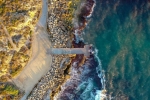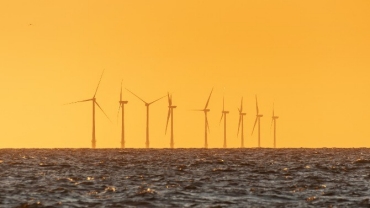
Momentum is building in the Australian offshore wind market
By Katie Barnett
Share this article
Australia’s apprehension towards deploying new clean energy technologies appears to be diminishing as coal generator outages continue to disrupt electricity supply and plant closures are brought forward. Following the election of a new Federal Labor government, Australia has legislated, economy-wide emissions reduction targets of reducing net greenhouse gas emissions to zero (NZE) by 2050 and committed to renewable energy comprising 82% of the electricity capacity mix in the National Electricity Market (NEM) by 2030. As existing onshore renewables markets mature and onshore sites with strong resource, proximity to system secure transmission with strong social license become scarcer, the domestic renewables industry is earnestly considering offshore wind (OffSW). Despite there being little attention for OffSW in Australia until recently, it is now indispensable to the NZE plans of many Western European and Asian economies.
Australia is a fundamentally different market and has no shortage of land for onshore renewable generation (variable renewable energy, or VRE) options which are (currently) more cost effective. Assessing OffSW against onshore wind on the basis of project capital costs, or the levelized cost of energy (LCOE), indicates that where onshore options are available, they should currently be prioritised. However, drawing conclusions on this basis alone is simplistic:
- OffSW resources are stronger, more consistent, and more predictable, resulting in capacity factors in accessible offshore locations of around 55% (Blue Economy 2021: 7, 37) - equivalent to the UK’s best OffSW windfarms. Onshore wind in Australia generally has capacity factors around 30-35%.
- OffSW also has a complementary time-of-day generation profile to wind onshore, which may reduce some of the need for firming/storage build-out.
- OffSW can provide significant generation close to coastal load centres, contributing to grid strength and reducing overall energy losses in the system.
- To date, retirement of 8GW worth of coal plant has been announced by operators by 2030 due to market dynamics, while the Australian Energy Market Operator (AEMO) is forecasting 14GW total retirement of coal plants by 2030 (Integrated System Plan 2022 (2022 ISP) (AEMO, 2022: 9). OffSW will be deployed at scale (projects are 1-2GW in size), replenishing the supply deficit. Further, coastal transmission infrastructure vacated by exiting coal plant, can be made available and repurposed for OffSW.
- As coal generation decommissioning dates are brought forward, there will be thermal workforces that have skills and capabilities transferable to OffSW workforces (with appropriate training and reskilling), and local manufacturing opportunities to support OffSW. The Victorian State Government estimates the creation of 600 construction jobs per GW of OffSW capacity and 300 ongoing jobs (DELWP, 2022).
- VRE developers are increasingly having to contend with more local stakeholder issues onshore (social licence) and stakeholder fatigue in areas of high VRE penetration.
When assessing OffSW potential, it is important to have regard for whole-of-system benefits (e.g. more diversified time-weighted NEM generation mix) which are currently difficult to validate. Additionally, due to larger wind turbine generator (WTG) platforms, accelerated learning rates and technology improvements, OffSW LCOE is forecast to decrease significantly– recent research forecasts initial LCOE of around $94/MWh in the mid-2020s to drop to $40 - $63 by 2050 (compared to $44/MWh for onshore wind in 2050) (DELWP, 2022: 21).
Australian governments are mobilising with a spate of recent announcements following the formative Offshore Electricity Infrastructure Act 2021 and the Offshore Electricity Infrastructure (Regulatory Levies) Act 2021 (collectively, the OEI) enacted in June 2022. The relevant OEI regulations and guidelines are being released in stages - the first, which cover the licensing schemes, fees and treatment of existing infrastructure, was released in final early November 2022, following consideration of feedback received on the March 2022 draft. The draft second tranche is expected in early 2023 and will cover management plans, financial security, protection zones and work health and safety.
The Federal Climate Change and Energy Minister Chris Bowen also recently announced six ‘designated OffSW zones’ spread between NSW, Vic, WA and Tas, which are awaiting declaration in order to commence the regulatory process around the granting of OffSW feasibility licenses. Applicants must apply for these seven-year feasibility licenses within the declared zones and applications are assessed against new merit criteria. Market sources suggest the first round of applications for feasibility licenses is currently expected to commence prior to Christmas with a 60 to 90-day application window. Sources also indicate that a 6 month assessment process has been advised, implying that the first feasibility applications would likely not be granted before the September quarter 2023. It is worth noting that feasibility licenses are competitive and cannot overlap – where two applications are made for the same area, a merit-based tiebreaker will take place to the extent the overlap cannot be resolved. A holder of a feasibility license can subsequently apply for a 40-year commercial license, which allows the developer to carry out an offshore infrastructure project for the purpose of exploiting renewable energy resources (similar to a petroleum production license).
The key parties responsible for administering the Federal licensing framework are summarized below:
| Body | Key OffSW functionality |
| Federal Minister for Climate Change and Energy | Makes all final decisions under the framework. |
| Federal Offshore Infrastructure Regulator (OIR) | Oversight and regulation of work, health and safety, environmental management, infrastructure integrity and financial security. Functions of the OIR are assumed by the National Offshore Petroleum Safety and Environmental Management Authority (NOPSEMA). |
| Federal Department of Climate Change, Energy, the Environment and Water (DCCEEW) | Supporting the Minister for Energy in identifying OffSW zones, and providing general support for the Minister's activities. |
| Federal Offshore Infrastructure Registrar | Assessing license applications and advising the Minister on their decision-making, and responsible for general license administration. National Offshore Petroleum Title Administrator (NOPTA) staff are deployed for use by the Registrar. |
At the State level, Victoria have been first movers with their March 2022 ‘Offshore Wind Directions Paper’ which set targets including 2GW of OffSW power by 2032 increasing to 9GW by 2040. Victoria subsequently released its ‘Offshore Wind Implementation Statement’ in October 2022, outlining various efforts to enable and facilitate these targets with focus on coordinated transmission, preferred ports, local content, workforce training and the interface between State and Federal legislation. This is likely to be closely followed by NSW, which is currently exploring setting OffSW generation targets, particularly following the significant OffSW representation amongst the Illawarra Renewable Energy Zone registrations of interest.
Projects are advancing
Approximately 30 Australian projects at various stages of development maturity have been announced, totaling up to 45GW in capacity, with much of the pipeline having been announced in the last 12 months following the enactment of the OEI. Only one project – Star of the South (SotS) (off Victoria’s Gippsland coast) – has secured an offshore exploration license area, and only a handful have lodged State and Commonwealth environmental approval documentation (e.g. Environmental Effects Statement in Victoria).
Keynote global OffSW developers involved in the Australian pipeline include Copenhagen Infrastructure Partners (CIP), who have a stake in SotS (and other sites) and Equinor, who have taken stakes in three of OceanEx’s projects. Iberdrola and Shell have also announced their intention to invest in Australian OffSW.
Given this, there is a spread of experience and financial capability behind announced projects. Based on limited publicly available information, around 60% of projects have secured investor partnerships. Some of the other major names currently include Corio (Macquarie Group) who are backing three projects, international player Bluefloat Energy which has four projects (backed by 547 Energy and Quantum Energy Partners), while recently formed Australian Green Energy Partners also bring significant international wind experience to four projects.
Fundamentals need efficiencies and innovation
The enthusiasm represented in the pipeline does not diminish the complexity of its undertaking, rather represents the market’s willingness to take on the challenge.
Pre-construction development costs include technical studies (site identification, wind resource assessments, seafloor mapping and bathymetry, grid injection, port readiness, cables and pipelines etc), environmental assessments (inc. fish, bird and mammal studies), securing the relevant approvals and ultimately locking down commercial licenses and exclusivity to secure essential construction, operating, debt and equity arrangements. Estimates put these development costs in excess of $100m or a.5-10x onshore projects. This is as much as the total capital costs of a 70MW onshore solar farm (based on CSIRO Gencost data, 2022: 67).
Construction is then lengthy, expensive and must be performed in a delicate, corrosive and often unpredictable marine environment, all while negotiating a complex contracting interface. Given the scale of these projects and the range of work packages and ancillary services needed, there is limited/no scope for wrapped Engineering, Procurement and Construction contracts (customary in the Australian onshore market) as contractors are unable and/or unwilling to provide all work packages as head contractor. OffSW projects therefore share characteristics of large infrastructure projects (rather than traditional power projects). While the European OffSW market is now substantially de-risked (relative to onshore wind), Australia’s nascent market and deeper waters will mean that even experienced OffSW players will need to innovate so OffSW’s LCOE decreases and the investor return spread to onshore wind widens (given the higher risks of OffSW).
The OffSW market is dominated by a handful of original equipment manufacturers (OEMs) (i.e. Vestas, Siemens Gamesa, Goldwind, GE) – attracting these manufacturers in-country will be key for the industry’s long-term prospects. For Australia, this means inducing manufacturers to invest in the Australian market with less pipeline visibility and with arguably riskier construction conditions. These OEMs are increasingly outsourcing production to Asia which geographically advantages Australia – it is likely that components will be imported from this market as the industry mobilises. Once pipeline certainty is established by multiple projects progressing Australia will be in a position to attract more substantial local OEM investment.
The OffSW ecosystem is complex and highly specialised in nature. This includes a range of specialised sea faring vessels (semi-submersible heavy lift vessels, crane barges, heavy cargo vessels, etc.) required to transport and install the huge WTGs and components, while port infrastructure also needs to be readied for the scale of the componentry.
Onshore vs Offshore
Onshore wind has been established as a fundamental source of renewable energy in Australia, with capacity of 9.7GW (October 2022), equivalent to 16% of total NEM capacity. While the 2022 ISP forecasts onshore wind to be the fastest growing form of VRE between now and 2030, it deliberately omits OffSW. Nevertheless, onshore wind development (and associated transmission) is becoming increasingly affected by social license issues with stakeholder fatigue in areas of high VRE penetration.
With these circumstances, OffSW has come into the spotlight as being an alternative energy source to reach Australia’s now legislated State and Federal energy transition goals, and its importance only grows when considering higher VRE NEM penetration scenarios. The tables below highlight key comparisons between the current status of onshore wind compared to offshore wind.
| Item | Onshore wind | Offshore wind | |
| Regulatory certainty | Certain, but for change in law risk - e.g. Victorian EPA Interim regulations expiring, new amendments proposed changes to noise requirements. |
Moderate level of uncertainty - whilst the Federal OEI has been enacted, only the first tranche of regulations has been issued. It will also be important to harmonise the Federal legislation interface with State legislation (most offshore seabeds have areas of State and Federal Crown land) to streamline regulatory certainty.
|
|
| Permitting | Approvals required vary by State, however track record provides certainty e.g. Planning permit required for use of land for wind facility under Victorian Planning Provisions (Victoria). |
Moderate level of uncertainty - as above, the Regulations are still evolving The Federal OEI highlights four types of licenses (feasibility, commercial, R&D and transmission/ infrastructure). Suitability to hold license assessed through Merit Criteria. State-based permits are also likely to be required (for both onshore and offshore arrangements).
|
|
Social License |
Becoming increasingly significant – less diversity of prime wind sites to choose from as the best sites are developed first and more marginal sites follow, and local communities suffer ‘stakeholder engagement fatigue’. E.g. Alinta’s Bald Hills wind farm, which was ordered by Victoria’s supreme court to partially switch off at night following complaints from local communities.
|
Likely to be less significant - offshore location means less likely issues around visual amenity and noise of generation assets, yet ecological and cultural heritage matters still need to be managed. Land connection will require community consultation. |
|
LCOE (A$/MWh) as at 2030 (CSIRO, 2022: 76)
|
40 - 59 | 90 – 163 (2.3x – 2.8x onshore wind)
|
|
Project costs (A$m/MW) as at 2030 in the 2050 NZE scenario (CSIRO, 2022: 68)
|
1.633 | 2.967 (1.8x onshore wind)
|
|
Estimated typical development timeframes |
4 - 5 years | 8 - 10 years (2.0x onshore wind)
|
|
Remobilising thermal workforce potential |
Smaller workforces - while onshore wind farm work forces can surge to 100-150 Full Time Equivalents (FTE) during construction, they need limited operational workforces (a.10 FTE, subject to size). |
Demonstrably larger workforces - regional thermal plant workforces can reskill and redeploy into construction (up to 600 FTE per GW installed) FTE and ongoing operating (300 FTE per GW installed) OffSW workforces (Victoria State Government, 2022: 27). Global Oil & Gas (O&G) players are looking to OffSW to decarbonise with offshore platforms representing potential workforce transition. |
|
Technology curve |
Relatively flat curve – onshore technology is highly mature yet will continue to evolve (e.g. larger WTG platforms). |
Steep curve – WTG platforms still regularly increasing in size and capacity floating technology is still being developed along with transmission models. |
|
| O&G adaptation | Limited – lesser direct relevance in experience or skillsets. | High - O&G players are active in OffSW globally and can apply vast capability and know-how in offshore environments (including resourcing and specialised ancillaries such as construction and operating vessels). |
|
Manufacturing potential |
Low-moderate - developed market with significant and visible pipeline, but componentry substantially imported – some nacelles and blades produced in Vic, as well as a WTG assembly facility. |
Moderate – as with onshore wind, supply chain is highly specialised and OEMs need to be attracted to Australia through a more visible pipeline and government incentives. WTG foundation manufacturing is likely to be first material local manufacturing opportunity. |
|
Key role for government to kick-start a new industry
It is clear the role for government will be significant in both establishing, scaling and maturing the OffSW industry in Australia. Overseas OffSW markets were and are still heavily supported, though some European markets are seeing the first OffSW projects without government-supported revenues (starting to emerge in the Netherlands and Germany). These unsubsidised projects are the culmination of decades of governments taking on significant costs and risks as pathfinders for private capital. Australia is in the privileged position to “learn and observe” the evolution of these overseas markets, bearing in mind the need for adaptation to local conditions.
Given its current high LCOEs, mission critical for OffSW is offtake certainty (and bankability). Given the scale of generation and project costs (especially) initially, governments need to commit to offtake certainty early for projects to assess feasibility and bankability. There are several key ways governments can provide revenue support, set out below:
| Subsidy mechanism | Description | Wholesale price exposure |
VRE support examples | |
| Feed-in tariff (FIT) | A guaranteed payment per MWh over a set contract period. These were used mostly in the early stages of renewable energy production – governments have generally shifted to more market-driven support mechanisms. |
Full protection - there is no exposure to merchant price changes. | Iterations of the ‘EEG’ regime in Germany; 20yr FIT regime in Taiwan |
|
Floating feed-in premium (Floating Premium)
|
An arrangement whereby the government will make up the difference between prevailing market prices where they are below a reference price. Where the market price is above the reference price, no payment is made. |
Full protection - there is no exposure to merchant price changes. | Iterations of the EEG regime in Germany
|
|
Contract for Difference (CfD) |
These arrangements are symmetrical versions of floating feed in-tariffs – while the government will “top-up” energy prices where they fall below the reference rate, the producer must repay the difference where energy prices are above the reference rate. |
Full protection against downside risks, though also results in repayment of upside (symmetrical structure). |
CfD auction regime in the UK |
|
| Fixed feed-in premium | A fixed amount is paid to the generator incremental to the price received on the spot market. | Full exposure to price movements, though generator benefits from a known subsidy on top of wholesale price. | Deployed in Spain between 1998 and 2013 | |
| Green certificates | Awarded to clean energy producers which are sold separately to the underlying energy itself – it permits energy consumers to purchase the positive externality associated with the clean energy production, representing an additional revenue stream for the producer. | Full exposure to price movements, though benefits from a floating subsidy on top of the wholesale price (green certificates have a separate market). | Renewable Energy Certificates in Australia | |
| Options | Offer the right to access a price floor in the event of wholesale markets decreasing below the strike price. | Exposure up to the point of the strike price, after which a price floor can be accessed. | Prospective LTESAs in NSW | |
The experience in OffSW in Europe and Asia has been a mix of the above, as subsidies provide different levels of exposure to merchant/market risks, the suitability of which has changed as the industry has matured.
Either a FIT, Floating Premium or CfD is expected to suit Australia given the total downside protection these mechanisms afford, which will allow developers to floor their offtake revenue, assisting with capital raising.
Road-mapping and readying infrastructure to be OffSW-capable will also be essential for State governments. The latest 16MW OffSW WTG platform blades are 252m in rotor diameter, with similar tower heights. To this end, the States need to assess port-readiness including deep water ports, large lay-down areas and component assembly areas. Whilst there are clear challenges apparent in the OffSW supply chain, Australia must ensure it is not hamstrung by inappropriate infrastructure. There is time to assess and address this if agencies start now. Encouragingly, in its recent Offshore Wind Implementation Statement, the Victorian Government has included a ports schedule and identified the Port of Hastings as suitable for redevelopment, the initial timing of which has been set for 2027 to align with the State’s OffSW targets.
Other options available to governments include tax incentive schemes like the Inflation Reduction Act (IRA) in the United States. Signed into law in August 2022, the IRA includes tax credits, incentives and other provisions intended to help tackle climate change, increase investment in renewable energy and enhance energy efficiency. Some of the key provisions related to OffSW cover:
- Tax credits - The primary federal tax provision supporting OffSW is the energy investment tax credit of 30% for project developers and 10% for component manufacturers and ancillaries like ships.
- Transmission - funding for the convening of stakeholders and perform studies on interregional and OffSW transmission.
Finally, pre-construction costs can also add up quickly – OffSW developers need to be incentivised to spend beyond the ‘site-grab’ stage. Governments potentially performing complex and costly offshore seabed mapping/ bathymetry analysis in area common to multiple sites and ‘open-sourcing’ the data may also prove valuable (rather than having developers duplicating each other’s efforts and costs), add to that a current scarcity of Australian consultants who can perform this work (leading to cost and time pressures).
Considerations for equity investors
A mammoth amount of investment will be required for current global 2030 OffSW targets to be met – a quick estimate places it between a.US$500b - $700b (based on data from CSIRO, 2022). To accommodate this, equity of every source is exploring OffSW internationally:
OffSW specialists such as Orsted are expanding their global coverage and leveraging technological expertise.
O&G players sense the opportunity to decarbonise their portfolios and potentially leverage their offshore platform expertise.
Strategic investors are expanding their generation portfolio, particularly attracted by OffSW’s enticing capacity factors and time-of-day shifting.
Financial investors with billions of capital to deploy are attracted to the large investment dollars which can be deployed in single transactions in OffSW (once de-risked).
In Australia, there are two broad groups of investors:
The large global fund managers and O&G players with large balance sheets are looking to decarbonise their asset portfolio.
Small and/or new developers with (experienced) management teams and a prospective site, but no balance sheet.
Large financial players such as CIP and Macquarie are backing projects. CBUS Super has also recently bought an early stake in SotS from CIP, representing (unexpectedly) early investment from the superannuation industry. For early development investors, securing quality management is essential; credible OffSW experience is a scarce resource.
The key issue for equity sponsors is the de-risking of project development (like similar large infrastructure projects). OffSW shares many characteristics with O&G projects and has been treated as such in developing OffSW markets in Asia. Equity sponsors need deep pools of development capital and may likely have to provide forms of credit support and/or delay and cost over-run wrapping during construction. Due to the scale of the GWh available and a need for some equity upside (given amplified risks compared to onshore wind), introducing and managing merchant/market income into the project’s revenue mix in particular with co-located storage capacity may also become a feature.
While proponents will be keen to initially have control/ ownership over all aspects of their projects, there may be a place for collaboration down the track – in transmission ownership/delivery structures, stakeholder management and potentially pooling efforts to generate some of the required environmental and technical data.
What does debt need to do to be ready to fund?
Lenders need to commence an education process of their regional credit committees across the risks and rewards of OffSW as the likely first step.
| OffSW rewards | Lender considerations |
Consistent, predictable and untapped generation |
|
| Scale and scalability of fees and margins |
|
Role for export credit agencies (ECAs) |
|
| OffSW - specific risks | Lender considerations |
Significant offtake is required for OffSW projects to be bankable |
|
Amplified construction risks |
|
Contracting interface risk management experience |
|
A colossal opportunity
The Australian OffSW industry’s current lack of progress relative to overseas markets also forms its biggest opportunity: the ability to form the industry from inception, whilst being able to leverage local learnings in onshore VRE and international lessons in what to do (and what not to do) when scaling OffSW. As evidenced overseas, when investing in OffSW, you are not simply investing in a new form of generation, but a significant infrastructure project with an entire ecosystem of skills and sub-industries needed to support projects that have the potential to power a million homes, each. It will be essential for State and Federal governments to get behind this new industry and for equity and debt to educate and bring along their investment and credit committees.
The extent to which the small but growing OffSW community has come together in Australia is evidence of an industry which has come a long way in a short amount of time. There is a general acknowledgement what is needed now is action and everything may not be perfect when taking the first steps setting-up a new industry – some mistakes may be made and lessons learned. Governments at all levels have come to the table with a level of coordination and commitment long not seen in Australia, evidenced most recently through Minister Bowen committing Australia to the Global Wind Alliance at COP27 – a knowledge-sharing alliance of governments and private companies with an overarching vision for 380GW of global OffSW deployment by 2030.
The biggest mistake for Australia at this stage would be to do nothing. What is most exciting is the Australian market has done it before with utility-scale onshore wind in the early 2000s and will do it again with OffSW. Those willing to take on the challenge will be rewarded with a world class resource and ability to deploy these learnings to the vast areas of viable Australian coastline.
December 2022
References
1. AEMO, 2022 Integrated System Plan, AEMO, 2022
2. Blue Economy Cooperative Research Centre (Blue Economy), Final Project Report: Offshore Wind Energy in Australia, Blue Economy, 2021
3. Victoria State Government, Offshore Wind Policy Directions Paper, Victoria State Government, 2022
4. Commonwealth Scientific and Industrial Research Organisation (CSIRO), GenCost 2021-22 Final Report, CSIRO, 2022
5. AEMO, NEM Generation Information October 2022, AEMO, 2022
Contact us

Managing Director, Energy Transition - Deals, PwC Australia
Tel: +61 410 537 892











